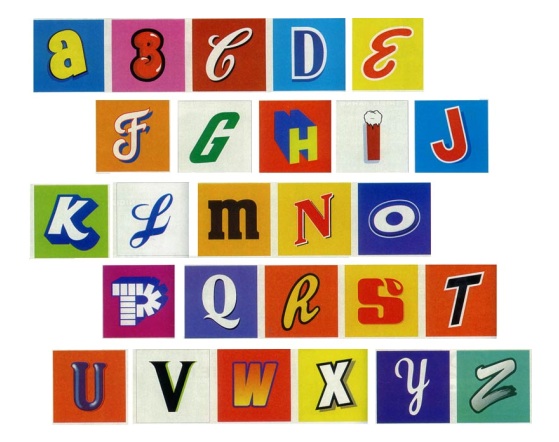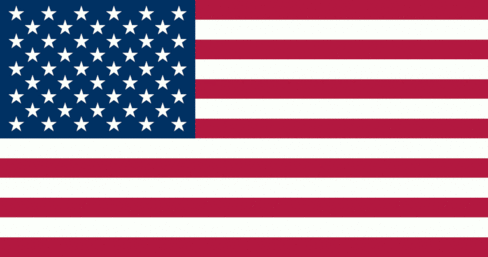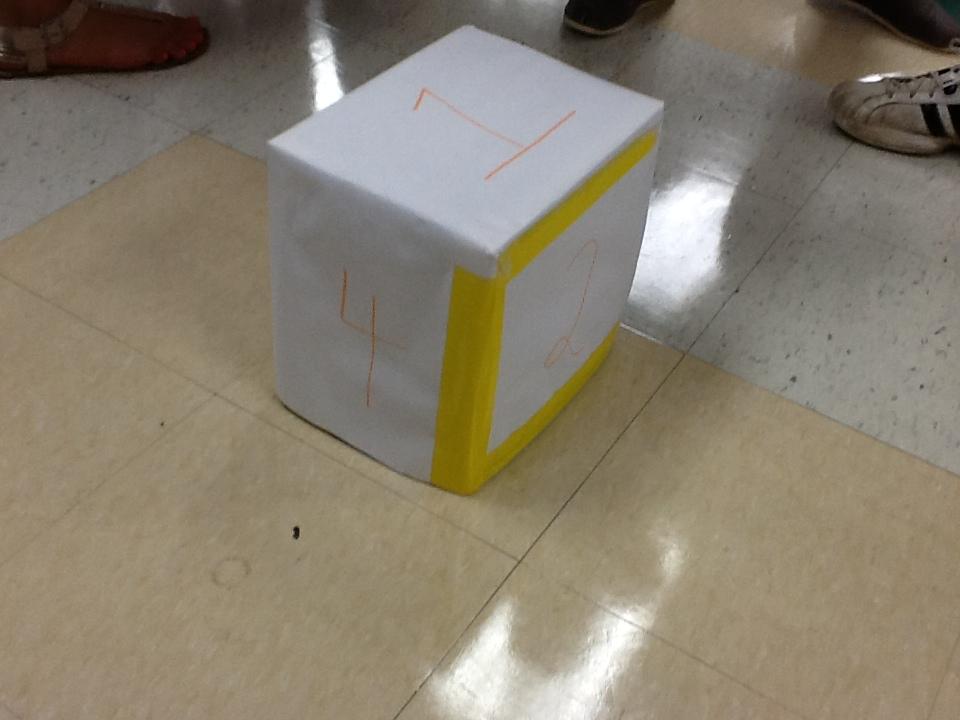This is a story about classroom culture. It includes an introduction to, what I suspect is, a novel concept--that of the
classroom brand. It is something that integrates marketing, psychology, and education. I suspect that this has been out there but not well defined as of yet. My hope is to shed some light on what I refer to as the
classroom brand and explain how I applied this concept to my own classes to create the classroom culture I was trying to foster in my students. The story I am about to tell is in two parts. The first part is the background and motivation for why I chose to brand my classroom, and the second is the story of my first year with a classroom brand.
 |
| The alphabet constructed out of popular brands. |
I would like to begin by disclosing that I am no researched expert on marketing nor the psychology of advertising, and so the thoughts here are my own. I have not seen in the literature nor in any personal blog or news article anything that describes what I call the
classroom brand, but that does not mean I am the first to note this. Much has been written about brands
in the classroom, but nothing about an actual classroom brand. Based on my own background in education, philosophy and cognitive psychology, I have compiled years of personal observation to examine how we are hard-wired to accept brands and branding based on the way in which our brains form associations. Once upon a time, someone pointed me to the
brand alphabet
to illustrate how associations were vital in learning. The alphabet has
now gone through several branding iterations since the original (shown
above) was created. You can even test yourself to see how many you would
get, which should make the argument for the power of branding pretty
compelling.
Perhaps what I point out here will seem obvious to you; but at the least, I hope that it seems a logical generalization about the nature of how we think as consumers which follows from your own experiential evidence. Finally, I hope that you can get a sense of what branding can do for a classroom, especially at the secondary level, because the age group responds so well to branding campaigns in general.
The power of the brand has been well known in the business world for years; however, looking around at other areas of life, you will likely find that branding has spread beyond a mere marketing tactic in business to almost all aspects of culture.
Brand recognition part of our cultural upbringing and it takes a hold on everyone, whether subconscious or not. Everyone gets exposure to certain products, games, services, and entertainment throughout their lives. They come to know, like, and dislike certain brands based on their experiences. As we mature, we begin not only to recognize brands, or to simply be aware of them, but we identify with them, or against them.
The pervasiveness of brands in culture can be seen in all countries and with all age groups. a survey of school children and college students from a couple of years ago describes top brand recognition. Though this article describes that teachers should take advantage of brands in their classroom, the context is different than what I am referring to here. Where this author suggests to use brands that students recognize in the classroom, such as Google or Microsoft, I am proposing that you create your own classroom brand--a brand that represents what your classroom stands for and the type of "product" you sell as an educator.
- Part 1: Motivation for a classroom brand - arguments for the power of branding

Few could argue that children are drawn to logos and products based on colors, shapes, or appealing design. Regardless of the type of product or the quality of it, children can recognize and even choose brands simply based on the visual it gives. Watch a parent with a small child in the grocery store checkout lane to see this for yourself. It's no accident that certain impulse shopping items, toys, and candy are all placed there. In adolescence, people become more aware of social branding. The products associated with fashion, style, class, and money start to work on the minds of kids in middle school. This motivates them to buy certain products to communicate a certain image to other people. Even the image that they choose to communicate has been branded and "sold" to adolescents--e.g., the skinny girl who wears a lot of makeup, or the male jock. The film
Miss Representation does an excellent job of illustrating the influence of branding on young girls in the long-lasting implications. Of course, some would call these image brands a "stereotype," but in the way that they are being pushed to consumers, they are an actual identifiable product themselves, and thus they are a brand. Everything from food, to entertainment, to personal image is branded for school-aged children to experience. Brands are ubiquitous, and a recent mobile app game called
Logos quiz very clearly points out this fact. In this game, you are given a set of logos for brands and try to guess the name of the brand based only on visual recognition. It was a very popular game with the high school students in my physics class this past year.
The experiences we have with brands as children and young adults then shape our brand associations and choices for the rest of our lives. To some degree, the extent to which we consume brands helps design and shape our self image, beliefs, perceptions, and personality. As adults, we are exposed to more abstract branding campaigns than those to which children are exposed. The brands start to come more in the form of beliefs and choices. An election year is a prime opportunity for one to see this at work. The President has initiated a campaign of '
forward' for 2012, in contrast to the '
change we need' that was behind his 2008 election. On the challenger's side,
Mitt Romney's team has launched a 'believe in America' campaign. Both candidates for president hope to compel voters to identify with them, but each has chosen to do so through branding and brand recognition. But this isn't the first time we have seen this sort of thing. Political campaigns have chosen to use branding for as long as they have been documented. Some simply refer to their "slogans" or "image," but these, I argue, are just iterations of branding.
The branding that takes place in political campaigns is one form of what is referred to as
personal branding, which some might learn about in
marketing school, but this is a form of branding where a brand that represents and stands for an individual is created that becomes bigger than the mere person alone. If you're unfamiliar with personal branding, you can immediately recognize personal branding if you think of a famous musical act, e.g., the Beatles, or Bob Marley. The Beatles are more than just their music, the musicians, or a logo. The Beatles is the brand that arose from the band. The same is true with Bob Marley--and if you consider politicians in the same way, the brand of Barack Obama or Mitt Romney overshadows the individuals themselves.
From childhood to adulthood, branding is a pervasive aspect of our lives. Branding even supersedes the cultural, business, or individual level. Having just finished the
2012 London Games, you might recall plenty of Olympic branding going on--"world togetherness, in sport."



Associated with this type of branding of an event is location-based branding, such as that which happens with cities, states, and countries. Branding campaigns such as "I love NY" and "
Pure Michigan" illustrate how locations want to sell themselves as their own brand. Perhaps the most noteworthy location-based branding you are familiar with is that of branding a country. When you see a country's flag, you are seeing its logo--it's brand. And that brand represents all that country embodies. We see the pride associated with the branding of a nation during times of war, tragedy, crisis, or unity. In the U.S., the flag so embodies our country's brand that people put flag stickers on their vehicles, buy U.S. flag clothing, or tint their windows and paint their cars with the stars and stripes. It's not just patriotism; it's branding.

Perhaps the most well-known branding is that associated with sports teams and even individual players. In sports entertainment, branding has had as much, if not more, success than the branding in any other area. From team logos, to players' numbers, to school colors, branding has helped to market and promote sports entities and institutions to the masses. There isn't anything bad about branding, it's just pervasive in the world. Sports is simply a prime example, from school-based athletics to professional leagues, sports team and player brands dominate.
Don't believe it? Take a guess what the first result will be when you do a
Google search for "Jordan."
 |
| Yea, it says "brand" too... |
- Addendum to Part 1: Inspiration from the social web
The success of branding in so many areas of life, especially business and entertainment marketing, shows, at least on the outside, the power that brands can have in representing a product, person, organization, event, location, or even a belief system. But since the dawn of social media and the social web, a new type of branding has arisen on the Internet and it has inspired a new approach to branding in other areas. This type of branding, for lack of a proper term, is an experiential brand. It is the type of brand that
Facebook,
Twitter,
Tumblr, and
Flickr all seek to create--one that is based on a shared experience and a type of social connectedness.
When you think of what the
Nike brand has done in their campaigns, they've gone from representing products to representing what can be done with those products. When it boils down to it though, Nike is still trying to sell a physical product. Now, contrast that with something like Facebook and what they are (were) trying to 'sell.' It wasn't a physical product, like Nike, but rather theirs is the experience of having (potentially) all the people you know in the same space to interact with while simultaneously documenting/chronicling your own life. This is
very different from selling a product. Certainly, Facebook has its critics, myself included, who '
dislike' some aspects of what Facebook has become, but you cannot argue that it is a brand that represents experience. The same is true of other social media companies out there. The sense of community that one gains from Facebook is the appeal; no matter what someone tells you, they didn't join to play
Farmville.
It's because of things like Farmville that I left Facebook a few years ago. The community became too cluttered and lost sight of its original purpose. When it became too cumbersome to navigate Facebook for the sense of connectedness I sought with my family and friends, I knew it was time to abandon ship. So,
I joined Twitter in 2009 and never looked back. Twitter seemed minimalistic enough to accomplish what I wanted out of a social networking sight--conversation with others and a sense of connectedness based on common interest. The more I learned on Twitter, the more I learned about Twitter...and the more I liked it. I quickly reached the
highest level of Twitter usage and decided it was time to start using it in my teaching with students and colleagues. That's when I learned something that was a game-changer for the way I thought of branding.
For the longest time, it seemed that you needed to have a big company, big idea, or simply have status worthy of devising a brand; however, on Twitter, anyone and everyone could create and market their own brand. This was ostensibly true to me, as was the nature of the potential for brand creation on twitter, when I saw the hashtag
#TeamFollowBack from one of my students in a tweet and then another in someone's profile. I didn't understand the terminology and had to ask a student to explain it to me: "It's just people who will follow you back," one physics student told me. Apparently, they didn't actually 'join' this team, they just identified with it and as they were being part of it through following the common tenet of "you follow me and I'll follow you back."
The more I looked into it, the more I began to notice #team__________ on Twitter. People create a hashtag for something they believe in, identify with, or want to promote and make a 'team' out of it that people can 'join' and feel a part of. There's everything from
#TeamJesus to #TeamSingle out there. So, this begged the question: could there be a #teamphysics? The more I thought about the possibility of a hashtag #TeamPhysics, the more I realized that it had to stand for something, it would have to be a brand of the experiential sort, but what would that even look like?
After mulling it over enough, I had the idea to
brand my classroom #TeamPhysics. I proposed the idea to my colleague
@mr_pata at our first staff meeting. "I think we should brand our classroom #TeamPhysics, because we really 'sell' a unique version of physics," I said at our department table group. Not a minute went by and the principal walked over to our science teacher table and said, "Good morning team science!" passed out some papers and moved on. We looked at each other, nodded, and realized it was a must do idea to brand the physics classroom. Between the power of brand awareness, social connectedness associated with brands, and the relevance of the #teamBRAND that is now all over Twitter, it made perfect sense to implement #TeamPhysics for the year--and that's just what I did.
- Part 2: What's a classroom brand?
When I think of a product brand, as described and illustrated above, I think about all the products, ideas, and experiences that are associated with that brand. Nike,
Just Do It, is a way of thinking as much as it is a pair of shoes or the feeling of accomplishment associated with sports performance.
When I think of how I would define a
classroom brand, it doesn't look much different. A
classroom brand is that which represents all that your classroom stands for--the ideas, experiences, norms, values, interactions, structure, and connectedness. For me, a classroom brand simply embodies what I want my classroom culture to be. That's why TeamPhysics was the perfect brand for my classroom. TeamPhysics is more than a mere moniker; it's more than a group; it's more than a logo; it's more than a hashtag. All of those things are necessary parts of it, but the essence of TeamPhysics is more than just the sum of its parts.
The motivation to create a classroom brand was compelling and from many sources, but the steps to implement a classroom brand were less clear. After lots of planning, I outlined
8 fundamental steps that were necessary for me to put the classroom brand idea into action. From children's cereal to university athletics to political campaigns, branding is a powerful mechanism for bringing people together and communicating. Branding and brand recognition has a strong appeal to people because it helps them to easily form associations between ideas, experiences, and products to a brand. It makes perfect sense to leverage this in the classroom and bring about a classroom brand to help students form the associations necessary for successful experience in a class.
BRAND YOUR CLASSROOM
























